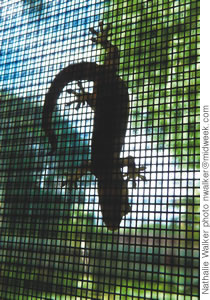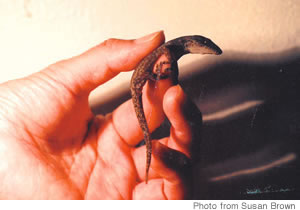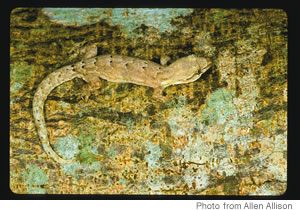A Nighttime Friend’s Secrets Revealed
The common house gecko is a walking pest control company that also inspires neat medical gadgets to improve human lives

By .(JavaScript must be enabled to view this email address)
E-mail this story | Print this page | Archive | RSS

|
They’re creepy,” declared a Honolulu woman. “They give me the heebie-jeebies! I saw one in my home office, sealed it shut and never entered that room again!”
So much for the aloha spirit.
The common house gecko arrived in Hawaii from Asia during World War II, according to Bishop Museum zoologist Allen Allison, and it’s been a friend to all - gobbling up roaches, mosquitoes and other annoying tropical bugs right and left, entertaining nightly with its song and dance on our window screens, selling beer, children’s stories, insurance, whatevahs.
Sandra Brown, a psychology professor at UH-Hilo, has grown quite fond of Hemidactylus frenatus, a nocturnal, grayish lizard with big eyes and a wedge-shaped head. She and her students - who clamber for the privilege - have studied the drab little gecko’s sexual behavior as well as its poop for years in the lab. She’s found no evidence of disease transmission from the kukae, by the way.
“There’s no real reason to fear geckos,” Brown says. “They cannot hurt a person even if they bite, because they have no teeth. I have had H. frenatus ‘hang’ from my fingers by their mouths.”
A friend also wore a pair on his ears to a costume party. But, then, there’s not much else happening at night in Hilo.
Brown’s uncle on Kauai had his new TV set shorted out by a burrowing gecko, however, and she warns folks to secure their computers from the “crack-avores” (meaning they hide in cracks during the day).
At Bishop Museum, meanwhile, Allison’s phone is busy with calls from residents who don’t like gecko droppings. “The number of pest calls we get are kind of surprising,” he says, “since they police the area for insects.” Both Allison and Brown tell annoyed humans that the best gecko control is to eliminate its food source - yet that’s exactly what the critters are already doing!
The complaints are often from residents whose kids have gone off to college, leaving their bedrooms undisturbed and inviting to little pooping tenants, Allison adds. “I tell them a cat will help.”
While cats enjoy playing with geckos before killing them, Brown notes that geckos also have their own set of tricks before dinner.

|
“When it’s got a large palmetto bug, you’ll hear a banging on the window, as they’re trying to knock it out - not kill it - because they don’t eat anything that’s dead.
“In fact, we had to raise our own fresh food for them in the lab.”
Brown also studies the behavior of snails and humans, which reveal interesting comparisons.
“Geckos lay the eggs, but there’s no follow-up parenting,” she says. No worries. She once had an egg hatch in her hand, and when she placed the newborn gecko in a fruit fly bin, he caught one right away.
Speaking of parenting, it takes a male and a female to reproduce H. frenatus. “You can tell the male by a bulge where its tail meets its body,” Brown explains. “The sac contains its two (yes, two!!) hemipenes, which are like a male penis.”
Hawaii’s mourning gecko (Lepidodactylus lugubris), a cream-colored reptile with dark spots that also patrols our homes, is asexual. Only females are in the Islands, Brown says, and they’re able to lay unfertilized eggs that develop into clones of themselves. That may be why they’ve survived here for hundreds of years.

|
At five pads per foot, the gecko’s sticky feet are much more famous than its droppings, and so is its detachable tail. Geckos and other lizards are the subject of decades of research as scientists try to replicate their amazing traits for human use. Academic journals contain ideas for new webbed bandages that could replace stitches or secure patients’ insulin pumps - all based on the design pattern of tiny bristle-like plates of hair on the gecko’s toe pads. The pads enable the little guy to stick to walls and ceilings as it wiggles swiftly along in its search for good grinds.
Researchers also have examined its ability to shed its tail as a distraction to predators. “They can just decide to drop their tail - the whole tail, or part of it,” says Brown. Amazingly, the dropped part continues to twitch. Thus, scientists ask, why not see if people paralyzed by spinal cord injuries can benefit, too? Not only that, but the gecko can regenerate the lost part. (A salamander, Allison says, can regenerate an entire limb!)
H. frenatus has plenty of cousins here leading pretty much the same good life, except when they happen to eat each other. The larger, more colorful species have moved up to the high-rent district as pets. Adoring online videos by pet owners are easy to find, as are gecko toys, books, logos and jokes. The Internet warns us that more may be on their way. A German tourist was caught smuggling 24 geckos (street value $35,850) out of a New Zealand airport in his underwear.
National Geographic Museum opened a gecko exhibit last fall in Washington, D.C., “featuring live geckos - some meek, some ferocious and some just adorable.”
That’s H. frenatus, all right.
Page 1 of 1 pages for this story
E-mail this story | Print this page | Comments (0) | Archive | RSS
Most Recent Comment(s):








